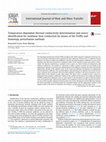Papers by Krzysztof Grysa
Applicationes Mathematicae, 1980
ABSTRACT An approximate analytical solution is obtained to the inverse problem of the temperature... more ABSTRACT An approximate analytical solution is obtained to the inverse problem of the temperature field within the framework of the theory of thermal stresses, i.e., the problem of the identification of temperature distribution. The solution of the direct (initial boundary) problem is used to obtain the formal solution to the inverse problem. Conditions for the admissible internal temperature and displacement responses are established; functions describing the internal responses are constructed; and the approximate solution is obtained. Several numerical examples illustrate the accuracy of the results.
Journal of Theoretical and Applied Mechanics, 1986
Journal of Theoretical and Applied Mechanics, 1979

Computer Assisted Mechanics and Engineering Sciences, 2009
The problem of thermal stresses in a hollow cylinder is considered. The problem is two-dimensiona... more The problem of thermal stresses in a hollow cylinder is considered. The problem is two-dimensional and the cross-section of the hollow cylinder is approximated as a long and thin rectangle as the ratio of the inner and outer radiuses is close to one. On the outer boundary of the hollow cylinder the heat source moves with a constant velocity. In the case of the rectangle the heat source moves on the upper side and the conditions of equality of temperatures and heat fluxes are assumed on the left and right boundaries. The stresses are to be found basing on the temperature measured inside the considered region, which means that an inverse problem is considered. Both for the temperature field and the displacements and stresses the finite element method is used. Thermal displacement potentials are introduced to find displacements and stresses. In order to construct the base functions in each element the Trefftz functions are used. For the temperature field the time-space finite elements are used and for the thermal displacement potentials the spatial elements are applied. Thanks to the use of the Trefftz functions a low-order approximation has given a solution very close to the exact one.
Journal of Theoretical and Applied Mechanics, 2012
The paper presents results of numerical calculations conducted in order to define the heat transf... more The paper presents results of numerical calculations conducted in order to define the heat transfer coefficient in flow boiling in a vertical minichannel with one side made of a heating foil with liquid crystals. During the experiment, we measured the local temperature of the foil, inlet and outlet liquid temperature and pressure, current and voltage drop of the electric power supplied to the heater. Local measurements of foil temperature were approximated with a linear combination of the Trefftz functions. The known temperature measurement errors allowed application of the adjustment calculus. The foil temperature distribution was determined by the FEM combined with the Trefftz functions. Local heat transfer coefficients between the foil and the boiling fluid were calculated from the third-kind condition.
Journal of Theoretical and Applied Mechanics, 1982
Journal of heat transfer, Jun 24, 2014
The paper presents a new approximate method of solving non-Fourier heat conduction problems. The ... more The paper presents a new approximate method of solving non-Fourier heat conduction problems. The approach described here is suitable for solving both direct and inverse problems. The way of generating Trefftz functions for non-Fourier heat conduction equation has been shown. Obtained functions have been used for solving direct and boundary inverse problems (identification of boundary condition). As a rule, inverse problems are ill-posed. Therefore, each method of solving these problems has to be checked according to disturbance of the input data. Presented examples confirm high usability of the presented approach for solving direct and inverse non-Fourier heat conduction problems.

International Journal of Heat and Mass Transfer, Sep 1, 2016
The homotopy perturbation method (HPM) combined with Trefftz method is employed to find the solut... more The homotopy perturbation method (HPM) combined with Trefftz method is employed to find the solution of two kinds of nonlinear inverse problems for heat conduction. The first one is a coefficient inverse problem. The thermal conductivity coefficient, with the prescribed boundary conditions on a part of the boundary and with some measured or anticipated values of the solution in some inner points, is determined. The thermal conductivity is assumed to have a form of a linear function of temperature with unknown coefficients. The number of T-functions in HPM is chosen to obtain the best fitting of the approximate solution to the input data. Minimization of the difference between the input data and the approximate solution of the problem, leads to the values of coefficients describing in an approximate way the unknown coefficients. The second problem is determination of an unknown source term for nonlinear stationary heat conduction with prescribed boundary conditions and some measured or anticipated values of the solution in some inner points. The source term is assumed to have a form of a polynomial with unknown coefficients. Number of the coefficients determines the number of functions in HPM resulting from expansion of Hðv; pÞ with respect to the parameter p in order to find the components of the approximate solution of the problem. The components consist of Trefftz functions for the linear parts of the resultant equations based on powers of p-terms. Minimization of the difference between the values prescribed or measured inside the considered domain and the approximate solution of the problem, leads to the values of coefficients describing in an approximate way the source term.
Journal of Theoretical and Applied Mechanics, 1977
Journal of Theoretical and Applied Mechanics, 1977

Computer Assisted Mechanics and Engineering Sciences, 2008
ABSTRACT In the paper the stationary 2D inverse heat conduction problems are considered. To obtai... more ABSTRACT In the paper the stationary 2D inverse heat conduction problems are considered. To obtain an approximate solution of the problems three variants of the FEM with harmonic polynomials (Trefftz functions for Laplace equation) as base functions were used: the continuous FEMT, the non-continuous FEMT and the nodeless FEMT. In order to ensure physical sense of the approximate solution, one of the aforementioned physical aspects is taken into account as a penalty term in the functional, which is to be minimized in order to solve the problem. Three kinds of physical aspects that can smooth the solution were used in the work. The first is the minimization of heat flux jump between the elements, the second is the minimization of the defect of energy dissipation and third is the minimization of the intensity of numerical entropy production. The quality of the approximate solutions was verified on two test examples. The method was applied to solve inverse problem of stationary heat transfer in a rib.

International Journal of Numerical Methods for Heat & Fluid Flow, Jun 25, 2019
Purpose The purpose of this paper is to derive the Trefftz functions (T-functions) for the Pennes... more Purpose The purpose of this paper is to derive the Trefftz functions (T-functions) for the Pennes’ equation and for the single-phase-lag (SPL) model (hyperbolic equation) with perfusion and then comparing field of temperature in a flat slab made of skin in the case when perfusion is taken into account, with the situation when a Fourier model is considered. When considering the process of heat conduction in the skin, one needs to take into account the average values of its thermal properties. When in biological bodies relaxation time is of the order of 20 s, the thermal wave propagation appears. The initial-boundary problems for Pennes’ model and SPL with perfusion model are considered to investigate the effect of the finite velocity of heat in the skin, perfusion and thickness of the slab on the rate of the thermal wave attenuation. As a reference model, the solution of the classic Fourier heat transfer equation for the considered problems is calculated. A heat flux has direction perpendicular to the surface of skin, considered as a flat slab. Therefore, the equations depend only on time and one spatial variable. Design/methodology/approach First of all the T-functions for the Pennes’ equation and for the SPL model with perfusion are derived. Then, an approximate solutions of the problems are expressed in the form of a linear combination of the T-functions. The T-functions satisfy the equation modeling the problem under consideration. Therefore, approximating a solution of a problem with a linear combination of n T-functions one obtains a function that satisfies the equation. The unknown coefficients of the linear combination are obtained as a result of minimization of the functional that describes an inaccuracy of satisfying the initial and boundary conditions in a mean-square sense. Findings The sets of T-functions for the Pennes’ equation and for the SPL model with perfusion are derived. An infinite set of these functions is a complete set of functions and stands for a base functions layout for the space of solutions for the equation used to generate them. Then, an approximate solutions of the initial-boundary problem have been found and compared to find out the effect of finite velocity of heat in the skin, perfusion and thickness of the slab on the rate of the thermal wave attenuation. Research limitations/implications The methods used in the literature to find an approximate solution of any bioheat transfer problems are more complicated than the one used in the presented paper. However, it should be pointed out that there is some limitation concerning the T-function method, namely, the greater number of T-function is used, the greater condition number becomes. This limitation usually can be overcome using symbolic calculations or conducting calculations with a large number of significant digits. Originality/value The T-functions for the Pennes’ equation and for the SPL equation with perfusion have been reported in this paper for the first time. In the literature, the T-functions are known for other linear partial differential equations (e.g. harmonic functions for Laplace equation), but for the first time they have been derived for the two aforementioned equations. The results are discussed with respect to practical applications.

Journal of Theoretical and Applied Mechanics, 2008
The paper presents a new method of finding an approximate solution to the beam vibration problem.... more The paper presents a new method of finding an approximate solution to the beam vibration problem. The problem is described with a partial differential equation of the fourth order. Basically, linear differential equations can be solved by means of various methods. The key idea of the presented approach is to find polynomials (solving functions) that satisfy the considered differential equation identically. In this sense, it is a variant of the Trefftz method. The advantage of the method is that the approximate solution (a linear combination of the solving functions) satisfies the equation identically. The initial and boundary conditions are then satisfied approximately. The formulas for solving functions and their derivatives are obtained. The solving Trefftz functions can be used in the whole domain or can be used as base functions in nodeless FEM. Both cases are considered. A numerical example is included.
Journal of Thermal Biology, Aug 1, 2019
The presented study considers the equation of hyperbolic conduction of heat with perfusion in ord... more The presented study considers the equation of hyperbolic conduction of heat with perfusion in order to identify such intensity of spatial heat source that will lead to hyperthermia of a cancerous tumor placed in healthy tissue. The tumor is assumed to be in the form of a sphere with a small radius. In order that the determined intensity of the heat source does not damage healthy tissue, different temperature distributions as a function of time are anticipated at the tumor's border. The mathematical tools used are based on the Trefftz method. The results are presented in the form of numbers and graphs illustrating the intensity of the identified heat source and matching the obtained temperature distributions in the tumor to the predicted ones.
Engineering Analysis With Boundary Elements, Oct 1, 2018
Abstract In the article, the Trefftz method, belonging to the analytical-numerical methods, was u... more Abstract In the article, the Trefftz method, belonging to the analytical-numerical methods, was used to identify the heat transfer coefficient for Inconel during spray cooling at the part of boundary. A mathematical model of the process has been formulated using cylindrical coordinate. The heat transfer coefficient is identified based of the Robin condition at the cooled boundary. Trefftz functions for heat conduction equation in cylindrical dimensionless coordinates has been used to find an approximate solution of the problem. As the internal temperature responses the real data from measurements has been used. The result of calculation is similar to the obtained by the other method.

Journal of Thermal Stresses, Mar 9, 2011
The Trefftz functions method has been developed very quickly. The paper presents the application ... more The Trefftz functions method has been developed very quickly. The paper presents the application of this method to solving direct and inverse problems of elasticity and thermoelasticity. The system of equations for displacements is reduced to a system of wave equations. Then the wave polynomials (Trefftz functions for wave equation) as base functions for several variants of Finite Element Method are used. In the paper, continuous FEMT and substructuring are considered. In the case of thermoelasticity, the temperature field occurs as inhomogeneity in one of the wave equations. It is shown how to get the particular solution in 2D and 3D. When using FEMT, the difference of solutions between the elements has to be minimized. The mechanical energy of the body depends on the velocity of the displacements. Therefore, the difference of the velocities between the elements is also minimized – it is a kind of physical regularization. The quality of the approximate solutions of direct and inverse problem was verified on the test example.
Energies, Nov 10, 2022
This article is an open access article distributed under the terms and conditions of the Creative... more This article is an open access article distributed under the terms and conditions of the Creative Commons Attribution (CC BY
Energies, Jun 18, 2021
This article is an open access article distributed under the terms and conditions of the Creative... more This article is an open access article distributed under the terms and conditions of the Creative Commons Attribution (CC BY









Uploads
Papers by Krzysztof Grysa